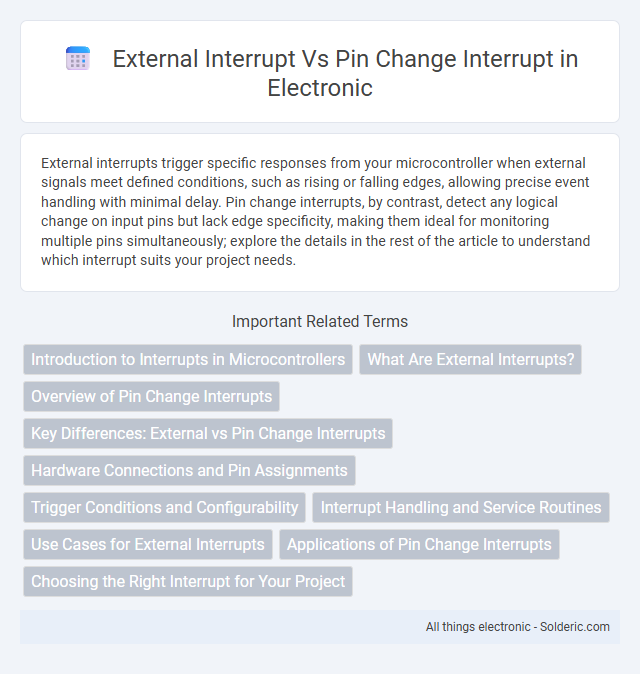External interrupts trigger specific responses from your microcontroller when external signals meet defined conditions, such as rising or falling edges, allowing precise event handling with minimal delay. Pin change interrupts, by contrast, detect any logical change on input pins but lack edge specificity, making them ideal for monitoring multiple pins simultaneously; explore the details in the rest of the article to understand which interrupt suits your project needs.
Comparison Table
| Feature | External Interrupt | Pin Change Interrupt |
|---|---|---|
| Trigger Source | Specific external pins (e.g., INT0, INT1) | Multiple general-purpose I/O pins across ports |
| Trigger Condition | Rising edge, falling edge, or low level | Any logical change (rising or falling edge) |
| Number of Interrupt Lines | Limited (typically 2 on many microcontrollers) | Multiple pins grouped by port (e.g., 8 per port) |
| Interrupt Vector | Dedicated vector per external interrupt | Shared vector per pin change interrupt group |
| Use Case | Precise edge detection on specific pins | Detect any pin state change on multiple pins |
| Example Microcontroller | AVR ATmega328P (INT0, INT1) | AVR ATmega328P (PCINT0..23) |
Introduction to Interrupts in Microcontrollers
External interrupts in microcontrollers respond to specific signals on designated pins, providing immediate attention to critical events like button presses or sensor outputs. Pin change interrupts monitor any change in logic state across a group of pins, offering broader detection but potentially less precision in pinpointing the exact source. Understanding these interrupts allows you to optimize device responsiveness and manage real-time control efficiently in embedded systems.
What Are External Interrupts?
External interrupts are hardware signals triggered by specific conditions on designated microcontroller pins, immediately halting the main program to service urgent tasks. They allow your system to respond quickly to events like button presses or sensor signals by executing an interrupt service routine (ISR). Unlike pin change interrupts, which detect changes on a group of pins, external interrupts are typically tied to specific pins with configurable triggering modes such as rising edge, falling edge, or logical level detection.
Overview of Pin Change Interrupts
Pin Change Interrupts allow microcontrollers to detect any logical change on a group of I/O pins, enabling response to state changes without continuous polling. Unlike External Interrupts, which are tied to specific pins and configured for rising, falling, or low-level triggers, Pin Change Interrupts monitor multiple pins simultaneously on designated pin change interrupt request (PCI) vectors. This capability provides flexible and efficient interrupt-driven input monitoring for applications requiring immediate detection of digital input transitions across various pins.
Key Differences: External vs Pin Change Interrupts
External interrupts are triggered by specific external signal line changes on dedicated interrupt pins, allowing for precise event detection and fast response times. Pin change interrupts monitor state changes on a group of pins within a port, providing broader but less specific detection without dedicated interrupt vectors. External interrupts typically offer configurable edge or level sensitivity, while pin change interrupts only detect any logical change on monitored pins.
Hardware Connections and Pin Assignments
External interrupts are typically assigned to dedicated pins specifically designed for interrupt signals, such as INT0 and INT1 on AVR microcontrollers, ensuring direct hardware connections that trigger immediate CPU response. Pin change interrupts, however, allow multiple GPIO pins to generate an interrupt through grouped pin change interrupt control registers, offering flexible pin assignments without dedicated hardware lines. Understanding your microcontroller's datasheet is crucial to correctly configure these hardware connections and optimize your interrupt handling strategy.
Trigger Conditions and Configurability
External interrupts are triggered by specific voltage level changes such as rising edge, falling edge, or low level, offering precise control over when the interrupt occurs. Pin change interrupts activate on any logical state change on designated pins, making them versatile but less specific in trigger conditions. Your choice between these depends on whether you need precise edge detection or a broader response to any pin state alteration.
Interrupt Handling and Service Routines
External interrupts trigger immediate execution of predefined Interrupt Service Routines (ISR) upon detecting specific signal changes on dedicated pins, ensuring low-latency response for critical events. Pin change interrupts monitor a wider set of pins for any state alteration, invoking a shared ISR that requires software routines to identify the exact pin causing the interrupt. Effective interrupt handling demands configuring interrupt vectors, prioritizing ISR execution times, and minimizing latency to maintain optimal microcontroller performance.
Use Cases for External Interrupts
External interrupts are ideal for time-sensitive events like pressing a button, sensor triggers, or communication signals that require immediate CPU attention. They provide rapid response to specific pins configured to detect rising, falling, or level changes, ensuring prompt handling of critical external events. These interrupts are commonly used in applications such as emergency stop buttons, rotary encoder inputs, and UART receive signals.
Applications of Pin Change Interrupts
Pin change interrupts are widely used in applications requiring detection of any logic level change on multiple input pins, such as rotary encoders, keypad inputs, and switch debouncing. They enable microcontrollers to respond to asynchronous events without continuous polling, improving efficiency in real-time systems. Unlike external interrupts tied to specific pins, pin change interrupts offer flexibility by monitoring a broader range of pins for state changes, making them ideal for dynamic input scenarios.
Choosing the Right Interrupt for Your Project
External interrupts are triggered by specific signal changes on designated pins, offering precise control for events like button presses or sensor signals, while pin change interrupts monitor changes on multiple pins simultaneously but with less specificity. Choosing the right interrupt depends on your project's need for accuracy and responsiveness; use external interrupts when exact timing matters, and pin change interrupts when monitoring multiple inputs efficiently is more critical. Your project benefits from understanding these distinctions to optimize performance and resource use.
External interrupt vs Pin change interrupt Infographic

 solderic.com
solderic.com